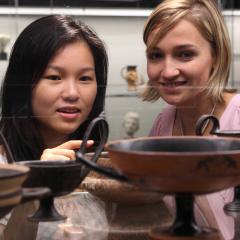A gift of 2 Cypriot antiquities to The University of Queensland’s RD Milns Antiquities Museum tells a story dating back to the Second World War.
A Bronze Age pottery juglet (1900-1650 BCE – UQ 24.001) and an Iron Age figurine fragment (700-500 BCE – UQ 24.002) were donated to the Antiquities Museum in late 2024 by Mr Peter Anderson, on behalf of his family. His father, Warrant Officer First Class Thomas Shaw Anderson (1908-1977), purchased the artefacts from the Cyprus Museum in Nicosia on Cyprus during the Second World War.
Peter said the antiquities have been a treasured part of his family homes for many years.

“As recognition of our father’s service in WW2, the family thought that it was appropriate that they should be donated to a teaching museum, where they could be studied and made available to a much wider range of people,” he said.
WO1 Anderson, born and educated in Brisbane, was stationed on Cyprus in 1941 with the 2/7th Cavalry (Commando) Regiment and also saw service in Egypt, Mandate Palestine, Syria, and Lebanon. On Cyprus, the regiment’s job was to fool the German army into thinking the island was held by a much larger number of troops.
The purchase of antiquities from the Nicosia Museum, while not possible today, was still a common practice in 1941.
After returning to Australia, the regiment was posted to New Guinea and served on the Sanananda Track in 1942.
According to Manager and Curator of the RD Milns Antiquities Museum, James Donaldson, Australian service personnel frequently took artefacts during their war service during both the First and Second World Wars.
“The practice of souveniring antiquities by Australian service personnel was very common during both wars, particularly in Egypt,” Mr Donaldson said.

“Like the more well-known collecting of trench-art, antiquities were something interesting from their travels for soldiers and nurses to show family members back home.”
The Museum sought formal advice from the Cypriot Antiquities Authority about the legal status of the artefacts prior to acquisition. They confirmed that the 2 artefacts were legally purchased in 1941, on the basis of sale room labels attached to them.
The Anderson family remember Thomas as a wonderful family man, reserved, but with an exceptional sense of humour.
“He was very well read, and the utterer of many sayings and quotes from literature. Sorely missed by all who knew him.”



